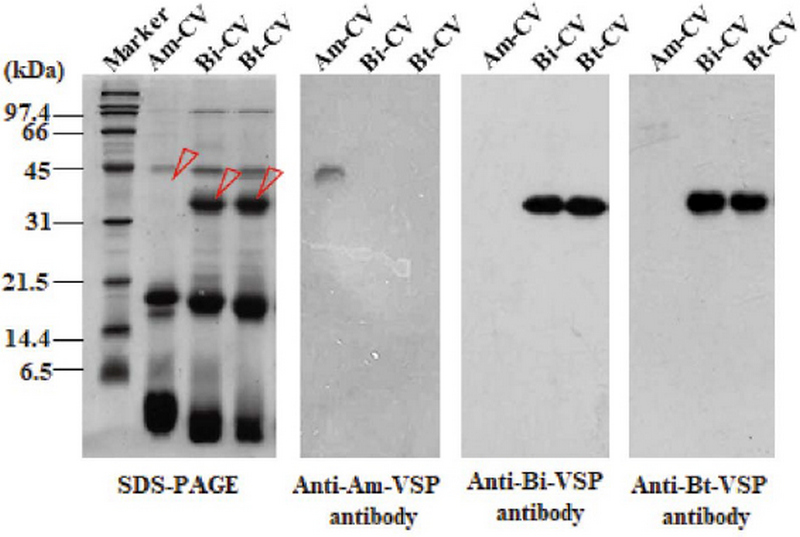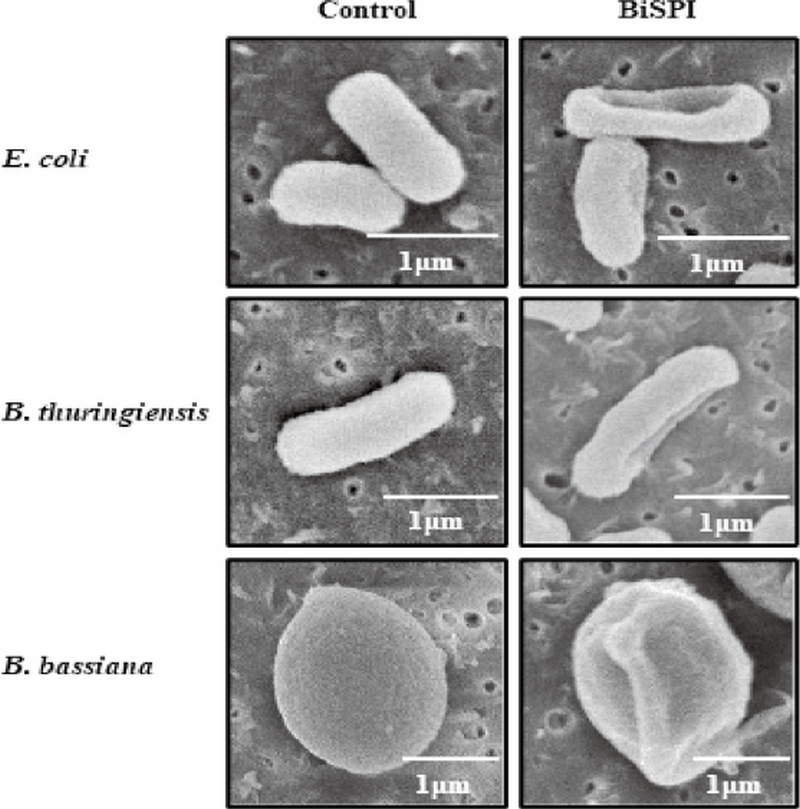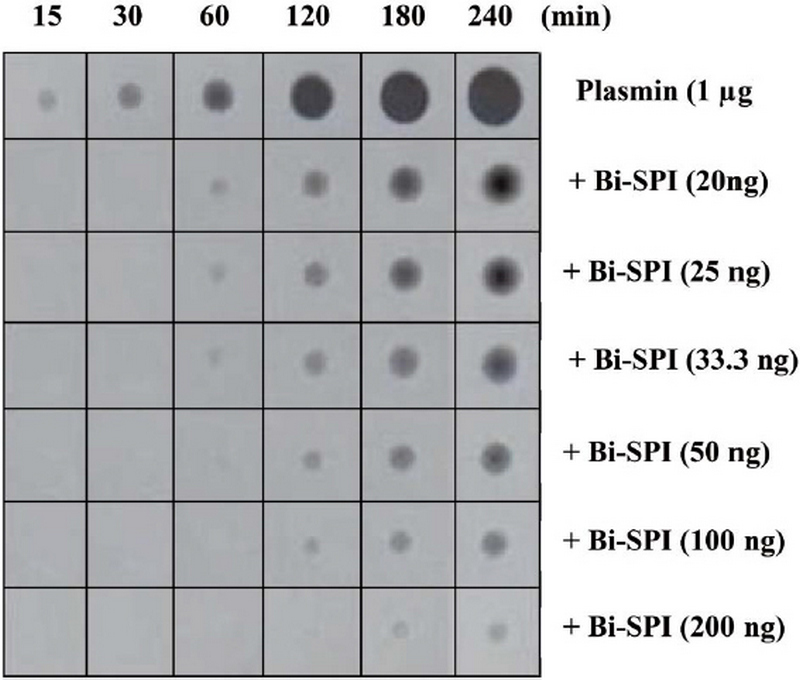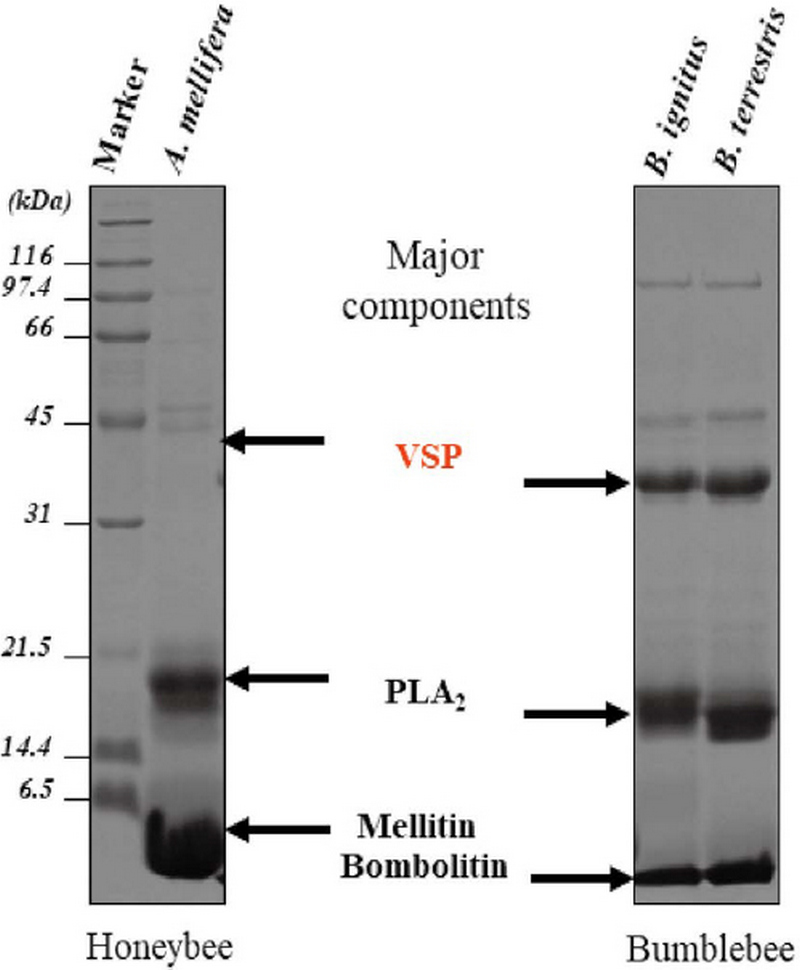
Proteases and Protease Inhibitors in Bee Venoms
Abstract
Bee venom is a complex mixture of various toxic components, including enzymes and peptides. While bee venom components can trigger local and systemic allergic reactions, they are also employed in traditional and alternative medicine for treating various diseases and managing venom allergies. Recent studies have shown a growing interest in bee venom components’ diverse biological, toxicological, and pharmacological effects. This study focuses on the roles of proteases and protease inhibitors in the venoms of honeybees and bumblebees. We conducted a review of the fibrinogenolytic activity exhibited by the serine proteases in bee venom as well as the multifunctional bee venom peptides that possess antifibrinolytic, anti-elastolytic, and antimicrobial properties.
Keywords:
Honeybee, Bumblebee, Protease, Protease inhibitors, VenomINTRODUCTION
In nature, there are some animals that possess venoms. Venomous animals include snakes, frogs, scorpions, bees, ants, and wasps. These animals use venom as a tool to capture prey or as a defense mechanism against predators. Venoms from such animals are known to cause severe harm to humans and have encouraged substantial research into the treatment and prevention of venom-related injuries. On the other hand, the venom of bees, particularly honeybees, has been utilized for pain relief and to treat conditions like arthritis through a traditional practice known as bee sting therapy (Son et al., 2007; Chen and Lariviere, 2010). In recent times, advancements in biotechnology have not only shed light on the pharmacological effects of venom components but have also led to the development and commercialization of various cosmetics using venom extracts from snakes and bees.
Considering these aspects, venoms can be seen as a double-edged sword. Just as medicines can sometimes have side effects, venoms can paradoxically possess medicinal properties. This review article focuses on bee venom components, such as proteases, protease inhibitors, and low-molecular-weight peptides, to explore the utilization of bee venom from both a human perspective and the perspective of the bees themselves.
MAIN COMPONENTS OF BEE VENOM
Two of the more commonly encountered species of bee are the honeybee (Apis mellifera), which is a beneficial insect for humans, and the bumblebee (Bombus spp.), which is commonly used in greenhouses and fields to pollinate crops (Velthuis and van Doorn, 2006). Venoms are commonly found in honeybees and bumblebees, which are readily encountered by humans and other animals. These bees use their venom as a defensive weapon against intruders. The quantity of venom protein released by honeybees in a single sting ranges from 50 to 140 μg, which is approximately five times higher than that released by bumblebees (10-31 μg per sting) (Hoffman and Jacobson, 1984; Schumacher et al., 1994). Unlike honeybees, bumblebees can sting multiple times without losing their stingers. Bee venom is known as a complex mixture of biologically, toxicologically, and pharmacologically active substances, including proteins, enzymes, and low-molecular-weight compounds (Son et al., 2007; Chen and Lariviere, 2010; Danneels et al., 2015). While bee venom can occasionally induce life-threatening allergic reactions because of the presence of various allergenic and non-allergenic molecules, it generally triggers acute local inflammatory responses.
The two major components of honeybee venom are melittin and phospholipase A2 (Fig. 1). Melittin, the most abundant component in bee venom, constitutes approximately 50% of its dry weight. Melittin consists of 26 amino acids and exhibits antibacterial and lytic activities (Habermann, 1972; Cruciani et al., 1991). Phospholipase A2, which accounts for approximately 12% of the dry weight of bee venom, is the most extensively studied toxic enzyme. Phospholipase A2 is known for its ability to induce pain and inflammatory responses (Hartman et al., 1991; Landucci et al., 2000; Six and Dennis, 2000). Bumblebee venom contains three major components: bombolitin, phospholipase A2, and serine proteases (Fig. 1). Bombolitin is the most abundant component in bumblebee venom and exhibits structural and biological similarities to melittin (Choo et al., 2010a; Qiu et al., 2012). Phospholipase A2 is also an important toxic component in bumblebee venom (Xin et al., 2009). Remarkably, bumblebee venom, unlike honeybee venom, includes serine proteases as major components that display fibrinogen and fibrinolytic/fibrinogenolytic activity (Choo et al., 2010b, 2011; Qiu et al., 2011). In addition, bee venom contains serine protease inhibitors with antifibrinolytic activity and low-molecular-weight peptides, such as secapin and inhibitor cysteine knot (ICK) peptides (Park et al., 2014; Lee et al., 2016). These serine protease inhibitors and low-molecular-weight peptides have been reported to exhibit antifibrinolytic and antimicrobial activities (Lee et al., 2016; Yang et al., 2017; Kim et al., 2022).
SERINE PROTEASES IN BEE VENOMS
Bee venom contains serine proteases, including a conserved catalytic triad (Ser, His, and Asp) that represents the main criterion for the classification of a protein as a serine protease (Choo et al., 2010b; Qiu et al., 2011). While serine proteases play a major role in bumblebee venom, they are present in trace amounts in honeybee venom (Fig. 2). Serine proteases in bee venom are expressed in the venom gland and are stored in the venom sac, where they are secreted through the stinger. Serine proteases found in bee venom possess various functions (Choo et al., 2010b; Qiu et al., 2011). In mammals, serine proteases from bee venom have been shown to activate the conversion of prothrombin to thrombin, act as thrombin-like serine proteases, and play a role as plasmin-like serine proteases (Fig. 3). These functions convert fibrinogen to fibrin and generate fibrin degradation products, demonstrating fibrinogenolytic activity. From a human perspective, the fibrinogen and fibrinolytic activity of bee venom serine proteases suggests their potential application as thrombolytic agents. On the other hand, considering that bee venom is a primary defense mechanism against intruders, the fibrinogen and fibrinolytic functions of serine proteases may contribute to the effective dispersion of bee venom components by lowering fibrinogen levels in mammalian blood, similar to what has been observed with snake venom serine proteases (Koh et al., 2001; Swenson and Markland, 2005; He et al., 2007), thus contributing to the efficient spread of the bee venom components through the bloodstream (Choo et al., 2010b; Qiu et al., 2011).

Serine proteases in honeybee and bumblebee venom (Qiu et al., 2011). Am-CV, Apis mellifera crude venom; Bi-CV, Bombus ignitus crude venom; Bt-CV, Bombus terrestris crude venom; Am-VSP, A. mellifera venom serine protease; Bi-VSP, B. ignitus venom serine protease; Bt-VSP, B. terrestris venom serine protease. The arrowheads indicate serine proteases in the venom.

Mechanisms of fibrinogen and fibrinolytic activity of bee venom serine protease and antifibrinolytic activity of bee venom serine protease inhibitor. Bi-VSP, Bombus ignitus venom serine protease; Bi-SPI, B. ignitus venom serine protease inhibitor.
In addition, bee venom serine proteases are involved in the formation of melanin, which is part of the humoral immune response in insects (Choo et al., 2010b). In insects, melanin is formed locally at the wound or microbial infection sites to aid in wound healing or killing infectious microbes. Bee venom serine proteases act as prophenoloxidase-activating enzymes that activate the conversion of prophenoloxidase into phenoloxidase. This function leads to a rapid and excessive melanin formation in the hemolymph of insects injected with bee venom, ultimately killing them. This strategy, which manipulates the innate immune system of insects, demonstrates a potential for pest control by disrupting insect physiology. As an example, introducing the gene of serine proteases from bumblebee (B. ignitus) venom into the entomopathogenic fungus Beauveria bassiana increased the insecticidal and virulence effects of the fungus (Kim et al., 2013b).
PROTEASE INHIBITORS IN BEE VENOMS
Protease inhibitors from the venoms of honeybees and bumblebees have been well-documented (Choo et al., 2012; Kim et al., 2013a, 2021, 2022; Qiu et al., 2013; Wan et al., 2014; Yang et al., 2017). The known serine protease inhibitors in honeybee and bumblebee venoms are cysteine-rich peptides consisting of 50-70 amino acids that inhibit enzymes like trypsin, chymotrypsin, or elastase. Bee venom serine protease inhibitors are known to inhibit the activity of microbial serine proteases as well as the activity of plasmin in mammals. Furthermore, bee venom serine protease inhibitors exhibit antimicrobial activity by binding to the cell walls of both Gram-negative and Gram-positive bacteria as well as fungi, causing structural damage (Fig. 4). In addition, they demonstrate the antifibrinolytic activity by inhibiting the activity of plasmin, which converts fibrin into fibrin degradation products in mammals (Fig. 5). Nevertheless, bee venom serine protease inhibitors do not show erythrocyte lytic activity in mammals (Kim et al., 2022). These compounds’ antifibrinolytic and antimicrobial activities suggest their potential application as anticoagulants or antimicrobial agents. The anti-fibrinolytic function of serine protease inhibitors is considered a means to reduce the venom’s leakage by promoting blood clotting at the site of the sting, similar to what has been observed in snake venom serine protease inhibitors (Masci et al., 2000; Flight et al., 2009; Choo et al., 2012).

Antimicrobial activity of bee venom serine protease inhibitors (Kim et al., 2022). BiSPI, Bombus ignitus venom serine protease inhibitor.

Inhibitory activity of the plasmin of the bee venom serine protease inhibitor (Choo et al., 2012). Bi-SPI, Bombus ignitus venom serine protease inhibitor.
Bee venom is known to contain proteinase inhibitors besides serine protease inhibitors. Recently, a metalloprotease inhibitor that hinders plasmin activity and demonstrates antifibrinolytic activity was reported in the venom of B. ignitus bumblebees (Kim et al., 2021).
LOW-MOLECULAR-WEIGHT PEPTIDES IN BEE VENOMS
In addition to protease inhibitors with antifibrinolytic and antimicrobial activities, bee venom contains low-molecular-weight peptides with similar functions. The ICK peptide identified in the venom of the Asian honeybee (Apis cerana) exhibits insecticidal activity and functions as an antifungal peptide (Park et al., 2014, 2016). While the rapid and high insecticidal activity of bee venom ICK peptides has been demonstrated, the mechanism behind this activity has not yet been elucidated. The presence of the low-molecular-weight peptide secapin in honeybee venom has been known for some time (Gauldie et al., 1976), but research on its function is scarce. Recently, A. cerana secapin, consisting of 25 amino acid residues, was found to have various functions (Lee et al., 2016). Honeybee venom secapin not only exhibits serine protease inhibitory activity but also shows antifibrinolytic and anti-elastase activities. Moreover, secapin exhibits broad-spectrum antimicrobial activity against bacteria and fungi. The multifunctionality of secapin suggests its potential applications in blood clotting, anti-inflammatory, and antimicrobial functions.
Bee venom contains peptides with antimicrobial activity, as well as low-molecular-weight peptides. Recently, major royal jelly proteins (MRJPs) 8 and 9 in bee venom were identified as microbial serine proteases and antimicrobial agents (Lee et al., 2022). Amwaprin in bee venom was identified and characterized as a microbicidal and anti-elastolytic agent (Lee et al., 2023). Given that bee venom is a rich source of various peptides with toxicological and pharmacological effects (Son et al., 2007; Chen and Lariviere, 2010), the discovery of biologically active components in it will provide new insights into its properties.
CONCLUSION
Bee venom, as a defensive weapon used by bees, presents a fascinating avenue for future research with a wide range of potential applications. Bee venom has a complex composition, including phospholipase A2, serine proteases, serine protease inhibitors, melittin, and bombolitin, and has been historically used in folk medicine for various therapeutic purposes. Moreover, bee venom is applied in immunotherapy to treat allergies. As research continues to unveil the biological, toxicological, and pharmacological activities of bee venom components, they may emerge as the basis for the development of next-generation biological substances. These substances could find applications in medicine, biotechnology, and various industries, opening up new avenues for innovative treatments and therapies.
Acknowledgments
This research was funded by the Dong-A University Research Fund.
References
-
Chen, J. and W. R. Lariviere. 2010. The nociceptive and antinociceptive effects of bee venom injection and therapy: a double-edged sword. Prog. Neurobiol. 92: 151-183.
[https://doi.org/10.1016/j.pneurobio.2010.06.006]

-
Choo, Y. M., K. S. Lee, H. J. Yoon, Y. H. Je, S. W. Lee, H. D. Sohn and B. R. Jin. 2010a. Molecular cloning and antimicrobial activity of bombolitin from venom of the bumblebee Bombus ignitus. Comp. Biochem. Physiol. B 156: 168-173.
[https://doi.org/10.1016/j.cbpb.2010.03.007]

-
Choo, Y. M., K. S. Lee, H. J. Yoon, B. Y. Kim, M. R. Sohn, J. Y. Roh, Y. H. Je, N. J. Kim, I. Kim, S. D. Woo, H. D. Sohn and B. R. Jin. 2010b. Dual function of a bee venom serine protease: prophenoloxidase-activating factor in arthropods and fibrin(ogen)olytic enzyme in mammals. PLoS ONE 5: e10393.
[https://doi.org/10.1371/journal.pone.0010393]

-
Choo, Y. M., K. S. Lee, H. J. Yoon, Y. Qiu, H. Wan, M. R. Sohn, H. D. Sohn and B. R. Jin. 2012. Antifibrinolytic role of a bee venom serine protease inhibitor that acts as a plasmin inhibitor. PLoS ONE 7: e32269.
[https://doi.org/10.1371/journal.pone.0032269]

-
Choo, Y. M., Y. Qiu, H. J. Yoon, K. Y. Lee, H. D. Sohn and B. R. Jin. 2011. Enzymatic properties of a bee venom serine protease from the bumblebee Bombus ignitus. J. AsiaPac. Entomol. 14: 249-251.
[https://doi.org/10.1016/j.aspen.2011.03.009]

-
Cruciani, R. A., J. L. Barker, M. Zasloff, H. C. Chen and O. Colamonici. 1991. Antibiotic magainins exert cytolytic activity against transformed cell lines through channel formation. Proc. Natl Acad. Sci. U. S. A. 88: 3792-3796.
[https://doi.org/10.1073/pnas.88.9.3792]

-
Danneels, E. L., M. Van Vaerenbergh, G. Debyser, B. Devreese and D. C. de Graaf. 2015. Honeybee venom proteome profile of queens and winter bees as determined by a mass spectrometric approach. Toxins 7: 4468-4483.
[https://doi.org/10.3390/toxins7114468]

-
Flight, S. M., L. A. Johnson, Q. S. Du, R. L. Warner, M. Trabi, P. J. Gaffney, M. F. Lavin, J. de Jersey and P. P. Masci. 2009. Textilinin-1, an alternative anti-bleeding agent to aprotinin: Importance of plasmin inhibition in controlling blood loss. British J. Hematol. 145: 207-211.
[https://doi.org/10.1111/j.1365-2141.2009.07605.x]

-
Gauldie, J., J. M. Hanson, F. D. Rumjanek, R. A. Shipolini and C. A. Vernon. 1976. The peptide components of bee venom. Eur. J. Biochem. 61: 369-376.
[https://doi.org/10.1111/j.1432-1033.1976.tb10030.x]

-
Habermann, E. 1972. Bee and wasp venoms. Science 177: 314-322.
[https://doi.org/10.1126/science.177.4046.314]

-
Hartman, D. A., L. A. Tomchek, J. R. Lugay, A. C. Lewin, T. T. Chau and R. P. Carlson. 1991. Comparison of antiinflammatory and antiallergic drugs in the melittin-and D49 PLA2-induced mouse paw edema models. Agents Actions 34: 84-88.
[https://doi.org/10.1007/BF01993245]

-
He, J. and S. Chen, J. Gu. 2007. Identification and characterization of Harobin, a novel fibrin(ogen)olytic serine protease from a sea snake (Lapemis hardwickii). FEBS Lett. 581: 2965-2973.
[https://doi.org/10.1016/j.febslet.2007.05.047]

- Hoffman, D. R. and R. S. Jacobson. 1984. Allergens in Hymeoptera venom. XII - How much protein is in a sting? Ann. Allergy 52: 276-278.
-
Kim, B. Y., K. S. Lee, F. M. Zou, H. Wan, Y. S. Choi, H. J. Yoon, H. W. Kwon, Y. H. Je and B. R. Jin. 2013a. Antimicrobial activity of a honeybee (Apis cerana) venom Kazal-type serine protease inhibitor. Toxicon 76: 110-117.
[https://doi.org/10.1016/j.toxicon.2013.09.017]

-
Kim, B. Y., K. S. Lee, K. Y. Lee, H. J. Yoon and B. R. Jin. 2021. Anti-fibrinolytic activity of a metalloprotease inhibitor from bumblebee (Bombus ignitus) venom. Comp. Biochem. Physiol. C, Toxicol. Pharmacol. 245: 109042.
[https://doi.org/10.1016/j.cbpc.2021.109042]

-
Kim, B. Y., Y. H. Kim, M. J. Park, H. J. Yoon, K. Y. Lee, H. K. Kim, K. S. Lee and B. R. Jin. 2022. Dual function of a bumblebee (Bombus ignitus) serine protease inhibitor that acts as a microbicidal peptide and anti-fibrinolytic venom toxin. Dev. Comp. Immunol. 135: 104478.
[https://doi.org/10.1016/j.dci.2022.104478]

-
Kim, J. S., J. Y. Choi, J. H. Lee, J. B. Park, Z. Fu, Q. Liu, X. Tao, B. R. Jin, M. Skinner, B. L. Parker and Y. H. Je. 2013b. Bumblebee venom serine protease increases fungal insecticidal virulence by inducing insect melanization. PLoS ONE 8: e62555.
[https://doi.org/10.1371/journal.pone.0062555]

-
Koh, Y. S., K. H. Chung and D. S. Kim. 2001, Biochemical characterization of a thrombin-like enzyme and a fibrinolytic serine protease from snake (Agkistrodon saxatilis) venom. Toxicon 39: 555-560.
[https://doi.org/10.1016/S0041-0101(00)00169-0]

-
Landucci, E. C., M. Toyama, S. Marangoni, B. Oliveira, G. Cirino, E. Antunes and G. de Nucci. 2000. Effect of crotapotin and heparin on the rat paw oedemal induced by different secretory phospholipases A2. Toxicon 38: 199-208.
[https://doi.org/10.1016/S0041-0101(99)00143-9]

-
Lee, K. S., B. Y. Kim, H. J. Yoon, Y. S. Choi and B. R. Jin. 2016. Secapin, a bee venom peptide, exhibits anti-fibrinolytic, anti-elastolytic, and anti-microbial activities. Dev. Comp. Immunol. 63: 27-35.
[https://doi.org/10.1016/j.dci.2016.05.011]

-
Lee, K. S., B. Y. Kim, Y. H. Kim, Y. S. Choi and B. R. Jin. 2023. Identification of waprin and its microbicidal activity: a novel protein component of honeybee (Apis mellifera) venom. Comp. Biochem. Physiol. C, Toxicol. Pharmacol. 266: 109561.
[https://doi.org/10.1016/j.cbpc.2023.109561]

-
Lee, S. J., K. S. Lee, M. Ok, B. Y. Kim and B. R. Jin. 2022. Antimicrobial activity of major royal jelly protein 8 and 9 of honeybee (Apis mellifera) venom. J. Asia-Pac. Entomol. 25: 101964.
[https://doi.org/10.1016/j.aspen.2022.101964]

-
Masci, P. P., A. N. Whitaker, L. G. Sparrow, J. de Jersey, D. J. Winzor, D. J. Watters, M. F. Lavin and P. J. Gaffney. 2000. Textilinins from Pseudonaja textilis textilis. Characterization of two plasmin inhibitors that reduce bleeding in an animal model. Blood Coagul. Fibrinolysis 11: 385-393.
[https://doi.org/10.1097/00001721-200006000-00011]

-
Park, H. G., S. S. Kyung, K. S. Lee, B. Y. Kim, Y. S. Choi, H. J. Yoon, H. W. Kwon, Y. H. Je and B. R. Jin. 2014. Dual function of a bee (Apis cerana) inhibitor cysteine knot peptide that acts as an antifungal peptide and insecticidal venom toxin. Dev. Comp. Immunol. 47: 247-253.
[https://doi.org/10.1016/j.dci.2014.08.001]

-
Park, H. G., Y. Deng, K. S. Lee, B. Y. Kim, H. J. Yoon, K. Y. Lee and B. R. Jin. 2016. Molecular cloning and antifungal activity of an inhibitor cysteine knot peptide from the bumblebee Bombus ignitus. J. Asia-Pac. Entomol. 19: 59-64.
[https://doi.org/10.1016/j.aspen.2015.10.012]

-
Qiu, Y., K. S. Lee, Y. M. Choo, D. Kong, H. J. Yoon and B. R. Jin. 2013. Molecular cloning and antifibrinolytic activity of a serine protease inhibitor from bumblebee (Bombus terrestris) venom. Toxicon 63: 1-6.
[https://doi.org/10.1016/j.toxicon.2012.11.004]

-
Qiu, Y., Y. M. Choo, H. J. Yoon and B. R. Jin. 2012. Molecular cloning and antibacterial activity of bombolitin isolated from the venom of a bumblebee, Bombus terrestris. J. Asia-Pac. Entomol. 15: 21-25.
[https://doi.org/10.1016/j.aspen.2011.08.007]

-
Qiu, Y., Y. M. Choo, H. J. Yoon, J. Jia, Z. Cui, D. Wang, D. H. Kim, H. D. Sohn and B. R. Jin. 2011. Fibrin(ogen)olytic activity of bumblebee venom serine protease. Toxicol. Appl. Pharmacol. 255: 207-213.
[https://doi.org/10.1016/j.taap.2011.06.020]

-
Schumacher, M. J., M. S. Tveten and N. B. Egen. 1994. Rate and quantity of delivery of venom from honeybee stings, J. Allergy Clin. Immunol. 93: 831-835.
[https://doi.org/10.1016/0091-6749(94)90373-5]

-
Six, D. A. and E. A. Dennis. 2000. The expanding superfamily of phospholipase A2 enzymes: classification and characterization. Biochim. Biophys. Acta 1488: 1-19.
[https://doi.org/10.1016/S1388-1981(00)00105-0]

-
Son, D. J., J. W. Lee, Y. H. Lee, H. S. Song, C. K. Lee and J. T. Hong. 2007. Therapeutic application of anti-arthritis, pain-releasing, and anti-cancer effects of bee venom and its constituent compounds. Pharmacol. Ther. 115: 246-270.
[https://doi.org/10.1016/j.pharmthera.2007.04.004]

-
Swenson, S., Jr. and F. S. Markland. 2005. Snake venom fibrin(ogen)olytic enzymes. Toxicon 45: 1021-1039.
[https://doi.org/10.1016/j.toxicon.2005.02.027]

-
Velthuis, H. H. W. and A. van Doorn. 2006. A century of advances in bumblebee domestication and the economic and environmental aspects of its commercialization for pollination. Apidologie 37: 421-451.
[https://doi.org/10.1051/apido:2006019]

-
Wan, H., B. Y. Kim, K. S. Lee, H. J. Yoon, K. Y. Lee and B. R. Jin. 2014. A bumblebee (Bombus ignitus) venom serine protease inhibitor that acts as a microbial serine protease inhibitor. Comp. Biochem. Physiol. B, Biochem. Mol. Biol. 167: 59-64.
[https://doi.org/10.1016/j.cbpb.2013.10.002]

-
Xin, Y., Y. M. Choo, Z. Hu, K. S. Lee, H. J. Yoon, Z. Cui, H. D. Sohn and B. R. Jin. 2009. Molecular cloning and characterization of a venom phospholipase A2 from the bumblebee Bombus ignitus. Comp. Biochem. Physiol. B 154: 195-202.
[https://doi.org/10.1016/j.cbpb.2009.06.003]

-
Yang, J., K. S. Lee, B. Y. Kim, Y. S. Choi, H. J. Yoon, J. Jia and B. R. Jin. 2017. Anti-fibrinolytic and anti-microbial activities of a serine protease inhibitor from honeybee (Apis cerana) venom. Comp. Biochem. Physiol. C, Toxicol. Pharmacol. 201: 11-18.
[https://doi.org/10.1016/j.cbpc.2017.09.001]

